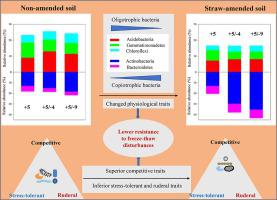Geoderma ( IF 5.6 ) Pub Date : 2022-06-17 , DOI: 10.1016/j.geoderma.2022.116007 Bin Zhang , Qi Chen , Jiahui Wen , Xueli Ding , Evgenios Agathokleous

|
Crop residues are usually returned into the soil after autumn harvest and maintained throughout the winter and early spring in temperate regions. This agricultural practice may exert important effects on soil microbial communities, consequently changing their compositional and functional stability to freeze–thaw disturbances later in the autumn and early spring. In this study, we examined the effect of straw addition on the composition and function of bacterial communities subjected to different intensities of freeze–thaw cycles in a clay loam soil. Bacterial composition in the control soils varied little after different freeze–thaw cycles. Freeze-thaw cycles, however, significantly changed the bacterial community composition in the straw-amended soils towards a less resistant community that was more vulnerable to freeze–thaw stress. A further analysis showed that straw addition significantly decreased bacterial alpha diversity and shifted soil bacterial community composition to one dominated by copiotrophs. Based on function predictions, the bacterial communities in the straw-amended soils presented superior competitive traits but inferior stress-tolerant and ruderal traits as compared to those in the control soils. Our results suggest that straw addition decreased the resistance of soil bacterial community composition to freeze–thaw disturbances through changes in their physiological and functional traits. These findings implicate that freeze–thaw cycles could exert important consequences on the functioning of agroecosystem when straw is returned into the soil.
中文翻译:

由于生理和功能性状的变化,秸秆添加降低了细菌群落组成对黏壤土冻融干扰的抵抗力
作物残茬通常在秋季收获后返回土壤中,并在温带地区的整个冬季和早春保持。这种农业实践可能对土壤微生物群落产生重要影响,从而改变它们的组成和功能稳定性,从而在秋季后期和早春出现冻融干扰。在这项研究中,我们研究了添加秸秆对粘土壤土中不同强度冻融循环的细菌群落组成和功能的影响。在不同的冻融循环后,对照土壤中的细菌组成变化不大。然而,冻融循环显着改变了秸秆改良土壤中的细菌群落组成,使其成为更容易受到冻融胁迫的抗性较低的群落。进一步的分析表明,秸秆的添加显着降低了细菌的α多样性,并将土壤细菌群落组成转变为以富营养型为主的群落组成。根据功能预测,与对照土壤相比,秸秆改良土壤中的细菌群落表现出优越的竞争性状,但抗逆性和粗鲁性状较差。我们的研究结果表明,秸秆添加通过改变其生理和功能特性降低了土壤细菌群落组成对冻融干扰的抵抗力。这些发现表明,当稻草返回土壤时,冻融循环可能对农业生态系统的功能产生重要影响。









































 京公网安备 11010802027423号
京公网安备 11010802027423号